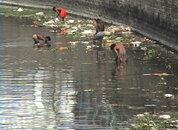How sad. It sounded as though any one of the divers could have found themselves in this peril.
Some things to note are:
1. Flow through the pipes in the chamber (whether leaking or open to the chamber or not) affected power generation. There are power supply obligations, cost, and customers that are affected and that affect decisions to cut off of flow and shutdown (if even possible).
2. Diving operations near anything that will produce suction, even temporary flooding of a pipe, is risky and requires planning from the designers, the owner, and the installation / dive contractors. Even 2-inch pipe for temporary flooding requires a diver "cage" to provide safety distance between the suction and the diver in case the diver(s) get too close.
3. This was not an installation task. This was a repair. Also, the suction was due to constant flow through a dam. Flow (suction) would not stop unless a valve (if installed) were closed. This is not the same as a pipeline that has finite distance where flow and suction would stop once an empty pipeline completely fills.
4. It is unclear whether there were manual or remotely controlled valves that could have cut off flow (and hence the suction) through the pipe downstream from the diver's stuck leg. There are also issues with the possibility that sometimes, valves do not seal as intended and do leak across the seals if there is damage, wear, or manufacturing defects.
5. Even if there were valves that could be accesssed for closure, monetary and contractual power obligations may have played a role in not "shutting down" flow and potential power generation. Remember the Piper Alpha incident? Read up on it. One of the most famous offshore platform accidents that continues to influence design and operations. Essentially a liquid leak coaght fire, damaged a high presure gas pipeline/riser/topsides system. There were no isolation valves between the source of gas flow to the platform between the seabed at the source platform and the location of the damage/leak/fire on Piper Alpha. The source of the gas flow was from another platform, miles away. Men on the source gas platform saw the fire, but were too afraid of the consequences to close there valves, shut-oof their compressors, shut-in their wells in order to shut down gas flow to Piper Alpha. The gas continued to flow to the fire and was being wasted as it fed as devastating fire on Piper Alpha. Good things have come from the lessons learned, but stupid stuff happens when complete shut-down means shut down of cash flow and/or costly and time consuming re-starts, also. I am not saying this entered into the picture, but it is a potential consideration.
6. In terms of safety, I think the safest thing to do was to shut down flow with a valve. If no valve or no access to install a new valve, then there are very limited safety precautions that copuld have completely prevented all accidents. The divers were limited to what they could carry. There was no overhead access by a crane line/chain/wire.
7. One possibility would have been to fabricate a pig tray to isolate the distance between the suction and a makeshift insertion point for a sealing pig that could be lowered into the pipe, held in position with a tied off chain/wire, sealed upon remote signal, removal of chain/wire, and then remotely released with a signal once repairs were complete. This takes a lot of money, but it may be the only acceptable option. Potential hinderences could be consideration of where the pig would end up once released and whether it would damage anything downstream. If something could be damaged or if there were obstructions or moving parts that could get the pig stuck, then some other solution is/would-have-been required.
8. Just cutting off the leg was dangerous. The leg could have been sucked through, resulting in increased suction for the divers doing the cutting. Simply cutting the pipe downstream from the coaght leg/foot would cause suction to relocate to the cut. Specially anchored cutting equipment would be required with sufficient offset to the divers operating the equipment (bulky too, and possibly tedious to carry in to such a confiened small space). Manual saws or cutting torches would be out of the question. The equipment (if used) may have to have been left in place until flow/suction could be stopped. Very expensive.
This is sad, Blood flow/pain/fatigue/dehydration seemed to all play a role in teh death. People have died from similar situations such as hanging from a poorly attached rope (as opposed to a harness) for a half a day or less and from being trapped in caves by the ankle due to cave-ins for several days. This incident is another bad way to die when consideration the constriciton on the body parts took a toll that over time, caused a death to someone who was not terribly injured at the onset of the incident.





